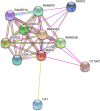Common variants in MAEA gene contributed the susceptibility to osteoporosis in Han Chinese postmenopausal women
- PMID: 33423677
- PMCID: PMC7798333
- DOI: 10.1186/s13018-020-02140-4
Common variants in MAEA gene contributed the susceptibility to osteoporosis in Han Chinese postmenopausal women
Abstract
Background: Osteoporosis (OP) is a complex bone metabolism disorder characterized by the loss of bone minerals and an increased risk of bone fracture. A recent study reported the relationship of the macrophage erythroblast attacher gene (MAEA) with low bone mineral density in postmenopausal Japanese women. Our study aimed to investigate the association of MAEA with postmenopausal osteoporosis (PMOP) in Han Chinese individuals.
Methods: A total of 968 unrelated postmenopausal Chinese women comprising 484 patients with PMOP and 484 controls were recruited. Four tag single nucleotide polymorphisms (SNPs) that covered the gene region of MAEA were chosen for genotyping. Single SNP and haplotypic association analyses were performed, and analysis of variance was conducted to test the correlation between blood MAEA protein level and genotypes of associated SNPs.
Results: SNP rs6815464 was significantly associated with the risk of PMOP. The C allele of rs6815464 was strongly correlated with the decreased risk of PMOP in our study subjects (OR[95% CI]=0.75[0.63-0.89], P=0.0015). Significant differences in MAEA protein blood levels among genotypes of SNP rs6815464 were identified in both the PMOP (F=6.82, P=0.0012) and control groups (F=11.5, P=0.00001). The C allele was positively associated with decreased MAEA protein levels in blood.
Conclusion: This case-control study on Chinese postmenopausal women suggested an association between SNP rs6815464 of MAEA and PMOP. Further analyses showed that genotypes of SNP rs6815464 were also associated with the blood level of MAEA protein.
Keywords: Case-control study; Genetic association; Postmenopausal osteoporosis; Single nucleotide polymorphisms.
Conflict of interest statement
None.
Figures
Similar articles
-
A polymorphism rs6815464 in the macrophage erythroblast attacher gene is associated with low bone mineral density in postmenopausal Japanese women.Gene. 2019 Jun 5;700:1-6. doi: 10.1016/j.gene.2019.03.027. Epub 2019 Mar 16. Gene. 2019. PMID: 30890479
-
Genetic susceptibility of postmenopausal osteoporosis on sulfide quinone reductase-like gene.Osteoporos Int. 2018 Sep;29(9):2041-2047. doi: 10.1007/s00198-018-4575-9. Epub 2018 May 31. Osteoporos Int. 2018. PMID: 29855663
-
Association between polymorphisms of glucagon-like peptide-1 receptor gene and susceptibility to osteoporosis in Chinese postmenopausal women.J Orthop Surg Res. 2024 Dec 23;19(1):869. doi: 10.1186/s13018-024-05361-z. J Orthop Surg Res. 2024. PMID: 39716293 Free PMC article.
-
The transforming growth factor-β1 (TGF-β1) gene polymorphisms (TGF-β1 T869C and TGF-β1 T29C) and susceptibility to postmenopausal osteoporosis: a meta-analysis.Medicine (Baltimore). 2015 Jan;94(4):e461. doi: 10.1097/MD.0000000000000461. Medicine (Baltimore). 2015. PMID: 25634187 Free PMC article. Review.
-
[Association of polymorphisms of the transforming growth factor-beta 1 gene with genetic susceptibility to osteoporosis].Rinsho Byori. 2001 Sep;49(9):900-5. Rinsho Byori. 2001. PMID: 11685778 Review. Japanese.
Cited by
-
Identification of Regulatory Factors and Prognostic Markers in Amyotrophic Lateral Sclerosis.Antioxidants (Basel). 2022 Feb 1;11(2):303. doi: 10.3390/antiox11020303. Antioxidants (Basel). 2022. PMID: 35204186 Free PMC article.
-
Functional genomics elucidates regulatory mechanisms of Parkinson's disease-associated variants.BMC Med. 2022 Feb 16;20(1):68. doi: 10.1186/s12916-022-02264-w. BMC Med. 2022. PMID: 35168626 Free PMC article.
-
Functional genomic analysis delineates regulatory mechanisms of GWAS-identified bipolar disorder risk variants.Genome Med. 2022 May 20;14(1):53. doi: 10.1186/s13073-022-01057-3. Genome Med. 2022. PMID: 35590387 Free PMC article.
References
MeSH terms
Substances
Grants and funding
LinkOut - more resources
Full Text Sources
Other Literature Sources
Molecular Biology Databases
Miscellaneous



